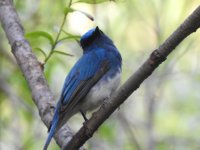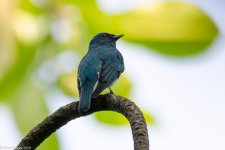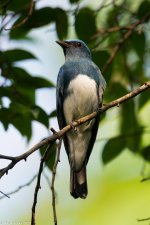-
Welcome to BirdForum, the internet's largest birding community with thousands of members from all over the world. The forums are dedicated to wild birds, birding, binoculars and equipment and all that goes with it.
Please register for an account to take part in the discussions in the forum, post your pictures in the gallery and more.
You are using an out of date browser. It may not display this or other websites correctly.
You should upgrade or use an alternative browser.
You should upgrade or use an alternative browser.
Blue-and-white or Zappey's Flycatcher? - Beijing, China (1 Viewer)
- Thread starter Lerxst
- Start date
More options
Who Replied?Andy Adcock
Worst person on Birdforum

I have no field experience of Zappey's but from illustrations, this bird has greater contrast with the crown and face than I'd expect for this species and I think the breast to belly demarcation, is too diffuse for this species?
A pity that the wings, seem to be obscuring the 'diagnostic'(?) white patch at the base of the tail sides.
A pity that the wings, seem to be obscuring the 'diagnostic'(?) white patch at the base of the tail sides.
Well as I said, I know these not but: when we say indetermina are we sure we don't mean intermedia? I couldn't find any evidence of former in (e.g.) Avibase. The original paper is here, I think:I have no field experience of Zappey's but from illustrations, this bird has greater contrast with the crown and face than I'd expect for this species and I think the breast to belly demarcation, is too diffuse for this species?
A pity that the wings, seem to be obscuring the 'diagnostic'(?) white patch at the base of the tail sides.
https://www.researchgate.net/publication/287163882_Zappey's_Flycatcher_Cyanoptila_cumatilis_a_forgotten_Chinese_breeding_endemic
The photos of Zappey's there seem consistent with yours I think: note the brighter cap on both species.
This is just a comment (or a question) - in Japan we have only cyanomelana, or at least I've only seen adult male birds with a black breast, so I can't give an opinion on cumatilis or intermedia.Well as I said, I know these not but: when we say indetermina are we sure we don't mean intermedia? I couldn't find any evidence of former in (e.g.) Avibase. The original paper is here, I think:
https://www.researchgate.net/publication/287163882_Zappey's_Flycatcher_Cyanoptila_cumatilis_a_forgotten_Chinese_breeding_endemic
The photos of Zappey's there seem consistent with yours I think: note the brighter cap on both species.
In the paper the Fern links to, all the illustrations are skins only, no live birds. The 'cumatilis' in these photos are turquoise (very greenish blue) whereas cyanomelana (and 'intermedia') are bright blue. They are very different. Of course this could be due to differences in preservation methods, but normally one would think it reflects a genuine difference of live birds in the field. One screengrab of cumatilis skins from this paper attached below.
Also the paper states that a narrow black band between the blue chest and the white belly, as well as black vertical streaking on the back (against a blue background) are marks of the differentiation of cumatilis (and we can see this in some of the skins shown in the paper).
But if you look at 'Birds of the World' (formerly Handbook of Birds of the World, now under the Cornell University brand; subscription required) the photos illustrating 'Zappey's Flycatcher' (i.e. cumatilis, which is given species status) are blue, not turquoise, have no black band between the blue breast and the white belly, and no black streaking on the back that I can see. One photo from BofW attached below, which I hope counts as 'fair use' of their intellectual property. This is clearly a different bird from cyanomelana, but at the same time it doesn't seem at all to match the description of cumatilis in the paper cited which is the paper claiming species status for cumatilis.
This seems strange to me, and I wonder if anyone has any comments on this?
And online photos claiming to be Zappey's seem not to be from its supposed breeding range in central China, but from Thailand.
And there are, of course a lot of blue flycatcher species around Asia.
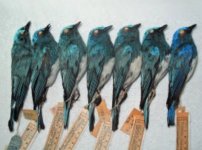
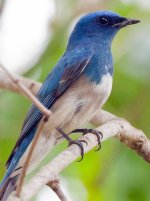
Last edited:
Andy Adcock
Worst person on Birdforum

Hence my comment about the diffuse nature of the breastband in my post Mac but it's not very obvious in any of the field guides that depict it. It seems to me that we really need to see this white spot at the base of the outer tail feathers.This is just a comment (or a question) - in Japan we have only cyanomelana, or at least I've only seen adult male birds with a black breast, so I can't give an opinion on cumatilis or intermedia.
Also the paper states that a narrow black band between the blue chest and the white belly, as well as black vertical streaking on the back (against a blue background) are marks of the differentiation of cumatilis (and we can see this in some of the skins shown in the paper).
It doesn't help that this looks like a first year bird?
Last edited:
Grahame Walbridge
Well-known member
Andy, to address one misconception first, cumatilis shows white in the base of the outer tail i.e pattern is identical to cyanomelana- I don't know what gave you that idea? And yes, the OP is 2cy male on account of dull (unmoulted) remiges, primary coverts, alula etc.
Mac, you must remember the descriptions you refer to https://static1.squarespace.com/sta...07842b1c/1545676011165/Zappeys-Flycatcher.pdf are from museum searches and, while the black streaks (which can be absent) would be clearly visible in the hand, I suggest this character is of little or no use in the field. The streaks are very fine (hairline) and are not normally visible in the vast majority of images, only those of the highest quality https://singaporebirds.com/species/zappeys-flycatcher/ Similarly, the narrow black which separates the breast band from the white underparts is often difficult to resolve and appears absent from the majority of images. Your r/h image from Thailand (where it is a regular passage migrant) is indeed an undoubted 2cy male Zappey's; combination of plumage tone, fine black streaks visible to the upper parts and breast, black confined to lores confirm ID.
Re the issue of cumatilis versus intermedia, this thread highlights the problems caused by the effects of lighting. Note the ID of both subjects has been confirmed by Paul Leader, the main author to the paper linked above. https://www.birdforum.net/threads/zappeys-flycatcher-shanghai-china.368301/#post-3790790 Once again, the fine black vertical streaks to the throat and breast of the Zappey's (l/h bird) are just visible, though the black breast line is hard to determine.
Finally, to the OP. The problems as I see it are the angle, the quality of the image and lighting, though it's safe to rule out nominate B&W. More images are posted (and comments) here https://www.birdforum.net/threads/blue-and-white-or-zappeys.405839/ viewing the additional images, there appear to be some black feathers present lower centre of the breast + plumage tones so, 2cy male intermedia B&W IMO.
Grahame
Mac, you must remember the descriptions you refer to https://static1.squarespace.com/sta...07842b1c/1545676011165/Zappeys-Flycatcher.pdf are from museum searches and, while the black streaks (which can be absent) would be clearly visible in the hand, I suggest this character is of little or no use in the field. The streaks are very fine (hairline) and are not normally visible in the vast majority of images, only those of the highest quality https://singaporebirds.com/species/zappeys-flycatcher/ Similarly, the narrow black which separates the breast band from the white underparts is often difficult to resolve and appears absent from the majority of images. Your r/h image from Thailand (where it is a regular passage migrant) is indeed an undoubted 2cy male Zappey's; combination of plumage tone, fine black streaks visible to the upper parts and breast, black confined to lores confirm ID.
Re the issue of cumatilis versus intermedia, this thread highlights the problems caused by the effects of lighting. Note the ID of both subjects has been confirmed by Paul Leader, the main author to the paper linked above. https://www.birdforum.net/threads/zappeys-flycatcher-shanghai-china.368301/#post-3790790 Once again, the fine black vertical streaks to the throat and breast of the Zappey's (l/h bird) are just visible, though the black breast line is hard to determine.
Finally, to the OP. The problems as I see it are the angle, the quality of the image and lighting, though it's safe to rule out nominate B&W. More images are posted (and comments) here https://www.birdforum.net/threads/blue-and-white-or-zappeys.405839/ viewing the additional images, there appear to be some black feathers present lower centre of the breast + plumage tones so, 2cy male intermedia B&W IMO.
Grahame
Grahame, that was precisely the point I was trying to make - only museum searches, but in 2012 when DNA separation would have been available.Mac, you must remember the descriptions you refer to https://static1.squarespace.com/sta...07842b1c/1545676011165/Zappeys-Flycatcher.pdf are from museum searches...
Grahame
Although they are not exceptionally rare, the paper by Leader and Carey doesn't refer to any live specimens of the birds (except for sound) or any DNA evidence (from live birds, or from the museum birds) for splitting. Maybe there is such evidence, but it always seems strange to me that there seems to be alway only this one paper referred to for saying differences are big enough to make a species split. Surely in ten years, it would have been easy to do a DNA analysis and show that these three groups were really separate.
And is the turquoise colour of the Beijing birds because of bad photography, or the way the birds were preserved in Beijing, or because of a genuine difference, in which case it is not shown in live birds?
Andy Adcock
Worst person on Birdforum

Because it's not mentioned in the field guide ( in this case Eaton et al ) description for cumatilis but it is for cyanomelana which would steer the inexperieced observer to conclude that it's an exclusive feature?Andy, to address one misconception first, cumatilis shows white in the base of the outer tail i.e pattern is identical to cyanomelana- I don't know what gave you that idea? And yes, the OP is 2cy male on account of dull (unmoulted) remiges, primary coverts, alula etc.
Last edited:
Lerxst
Well-known member
The MacKinnon and Phillips field guide for China isn't very helpful either. They do not mention intermedia at all, and their illustration of cumatilis shows a very dark throat - much darker than what is in my images. Mark Brazil's Birds of East Asia is similar. If they were all I had to go by I would be extremely confused.
Thanks to everyone taking the time to discuss this problematic ID.
Thanks to everyone taking the time to discuss this problematic ID.
Andy Adcock
Worst person on Birdforum

I can't by the way, see any images that show this 'black line' which is supposed to seperate breast and belly?
These photos by Viator are really interesting, because the blue is more turquoise than other photos and much closer to the colour of the cumatilis skins that are illustrated in the Leader and Carey paper, and which I copied in an attachment in my post above #7. As you can see (also in my post #7 which was indeed the main point of that post), the bird that illustrates Zappey's on 'Birds of the World' is a completely different shade of bright blue, as is the OP's bird which started this thread (and so is the bird illustrating Blue-and-White Flycatcher on BofW).To give another example here is a front and back view of a Zappey's in Singapore
My posts in this thread have not been intended to argue that someone is right or wrong about some detail of ID of these birds. In fact, I think there may be more sub-species than the three named. But I do think that in 2021, it ought to be possible for someone claiming that there are several groups worthy of species-level differentiation in a fairly large and easily seen bird to go beyond small differences of tail length and song to DNA level.
(My interest in this bird is partly because I have Blue Rockthrush phillipensis which breed on the roofs of the four- or five-storey apartment buildings I can see from the window as I type this (and pace Birds of the World, about as far as you can get from the sea in Japan, about 50km over two mountain ridges), and they look very different in colour from Blue Rockthrush pandoo, yet it seems that DNA will not allow them to be separated; so I wonder about Blue and White Flycatcher with seemingly less colour variation, and nobody quoting DNA evidence for splits.)
Paul Leader
Well-known member
An interesting post, and one I can perhaps shed some light on.
I am aware of further research into the taxonomy of Zappey’s and Blue and White Flycatcher, which supports the conclusions we came to in our 2012 paper, but this does not seem to have been published.
A fair amount has been learnt about Zappey’s since 2012 and whilst adult males are very distinctive, the black streaks on the mantle we made quite a lot of in our paper are in fact rarely shown. Most of our material for Zappey’s is from the main collection in Beijing, and from the Beijing area. Why Zappey’s in that area show such obvious black mantle streaks is somewhat bemusing. Likewise, the black at the base of the breast is not always apparent (but still seems to be diagnostic when present).
First-winter males tend to be a bit duller overall, such that cumatilis and intermedia and intermedia and cyanoptila are less easily distinguished in the field.
Having been sent many photos of this species pair since our paper was published, what is also obvious is how posture can greatly affect the tone and colour of the head and breast. I have seen photos of males that look like cumatilis in one photo and intermedia in the next. I now avoid commenting on single photos (unless obvious).
We also now know that cumatilis and intermedia breed sympatrically in the Beijing area. As such Lerxst, it would be good to see further images of the bird in the original post.
The name cumatilis had previously been ascribed, incorrectly to the populations in NE China (i.e. intermedia) hence the confusion in some of the older fieldguides.
MacNara, whilst I understand your frustration here, research such as you suggest takes a lot of time and resources. The research that went into our 2012 paper required two trips to Japan, two to Russia and one to north-east China. All self-funded. Our experience was that these are typically low-density species with males having huge territories, and often singing from the tops of large trees. Trapping is problematic even when you find them. In 2012 we felt that we had sufficient data to publish without DNA, even though we anticipated some criticism for taking this approach. If we had waited for DNA, I suspect we would have published nothing as yet. DNA from skins is problematic as you would need material from the breeding grounds only, and would require material from multiple museums in at least five countries.
Finally, intermediates between pandoo and phillipensis Blue Rock Thrushes seem to be fairly regular based on skin collections, despite typical adult males of both being very different.
I am aware of further research into the taxonomy of Zappey’s and Blue and White Flycatcher, which supports the conclusions we came to in our 2012 paper, but this does not seem to have been published.
A fair amount has been learnt about Zappey’s since 2012 and whilst adult males are very distinctive, the black streaks on the mantle we made quite a lot of in our paper are in fact rarely shown. Most of our material for Zappey’s is from the main collection in Beijing, and from the Beijing area. Why Zappey’s in that area show such obvious black mantle streaks is somewhat bemusing. Likewise, the black at the base of the breast is not always apparent (but still seems to be diagnostic when present).
First-winter males tend to be a bit duller overall, such that cumatilis and intermedia and intermedia and cyanoptila are less easily distinguished in the field.
Having been sent many photos of this species pair since our paper was published, what is also obvious is how posture can greatly affect the tone and colour of the head and breast. I have seen photos of males that look like cumatilis in one photo and intermedia in the next. I now avoid commenting on single photos (unless obvious).
We also now know that cumatilis and intermedia breed sympatrically in the Beijing area. As such Lerxst, it would be good to see further images of the bird in the original post.
The name cumatilis had previously been ascribed, incorrectly to the populations in NE China (i.e. intermedia) hence the confusion in some of the older fieldguides.
MacNara, whilst I understand your frustration here, research such as you suggest takes a lot of time and resources. The research that went into our 2012 paper required two trips to Japan, two to Russia and one to north-east China. All self-funded. Our experience was that these are typically low-density species with males having huge territories, and often singing from the tops of large trees. Trapping is problematic even when you find them. In 2012 we felt that we had sufficient data to publish without DNA, even though we anticipated some criticism for taking this approach. If we had waited for DNA, I suspect we would have published nothing as yet. DNA from skins is problematic as you would need material from the breeding grounds only, and would require material from multiple museums in at least five countries.
Finally, intermediates between pandoo and phillipensis Blue Rock Thrushes seem to be fairly regular based on skin collections, despite typical adult males of both being very different.
Paul Leader
Well-known member
I missed the link to other photos of the bird in the original post. given how dark the throat and breast it, I am confident this a first-year male intermedia.
It's very kind of you to reply, Dr Leader.An interesting post, and one I can perhaps shed some light on.
I am aware of further research into the taxonomy of Zappey’s and Blue and White Flycatcher, which supports the conclusions we came to in our 2012 paper, but this does not seem to have been published.
A fair amount has been learnt about Zappey’s since 2012 and whilst adult males are very distinctive, the black streaks on the mantle we made quite a lot of in our paper are in fact rarely shown. Most of our material for Zappey’s is from the main collection in Beijing, and from the Beijing area. Why Zappey’s in that area show such obvious black mantle streaks is somewhat bemusing. Likewise, the black at the base of the breast is not always apparent (but still seems to be diagnostic when present).
First-winter males tend to be a bit duller overall, such that cumatilis and intermedia and intermedia and cyanoptila are less easily distinguished in the field.
Having been sent many photos of this species pair since our paper was published, what is also obvious is how posture can greatly affect the tone and colour of the head and breast. I have seen photos of males that look like cumatilis in one photo and intermedia in the next. I now avoid commenting on single photos (unless obvious).
We also now know that cumatilis and intermedia breed sympatrically in the Beijing area. As such Lerxst, it would be good to see further images of the bird in the original post.
The name cumatilis had previously been ascribed, incorrectly to the populations in NE China (i.e. intermedia) hence the confusion in some of the older fieldguides.
MacNara, whilst I understand your frustration here, research such as you suggest takes a lot of time and resources. The research that went into our 2012 paper required two trips to Japan, two to Russia and one to north-east China. All self-funded. Our experience was that these are typically low-density species with males having huge territories, and often singing from the tops of large trees. Trapping is problematic even when you find them. In 2012 we felt that we had sufficient data to publish without DNA, even though we anticipated some criticism for taking this approach. If we had waited for DNA, I suspect we would have published nothing as yet. DNA from skins is problematic as you would need material from the breeding grounds only, and would require material from multiple museums in at least five countries.
Finally, intermediates between pandoo and phillipensis Blue Rock Thrushes seem to be fairly regular based on skin collections, despite typical adult males of both being very different.
For those of us in Japan, with not so many brightly- and beautifully-coloured birds, Blue-and-White Flycatcher is a treat because it is usually fairly well-hidden in dark spots but suddenly flashes this irridescent blue when it is hit by, or comes into, sunshine. Its lovely song is heard more often than the bird is seen, and is a pleasure of the hot early summer in itself.
I, myself, am just a regular 'birdwatcher' and only started after I was 50 (my experience is that some who got into birds when they were primary-school age notice things that I don't see and sometimes can't see even when they are pointed out). My point about Blue Rockthrush was not really about this bird as such, but about my psychology: given that phillipensis and pandoo look strongly different, but are yet held to be the same species, how does this apply to other birds.
I would still be interested to hear you opinion on the colours of the birds - the Beijing skins that you posted and which I copied in #7, and the bird posted by Viator in post #14 seem to me to be of a greenish-blue ('turquoise') that is quite different to the bright blue-blue of the bird which is put as the poster bird on Birds of the World for 'Zappey's' cumatilis or our Japanese cyanomelana, or the bird posted by Lerxst which started this thread. I find it very difficult to think that this green-blue is a faded version of the bright blue rather than the basic colouring of a quite different species. Are you saying that the birds in my post #7 - your skins, and the Birds of the World 'Zappey's' - are the same species (I completely accept that the Birds of the World bird is not our cyanomelana, but for me it is closer to cyanomelana than it is to the turquoise birds)?
..? Is there a link? Can't see one...I missed the link to other photos of the bird in the original post.
Andy Adcock
Worst person on Birdforum

I think it's fair to say that with the exception of the odd 'classic', a good number of examples if not most, are unidetifiable with any degree of safety, it will be interesting to see the DNA work when it's finished, will the split, ultimately stand?
Users who are viewing this thread
Total: 2 (members: 0, guests: 2)




